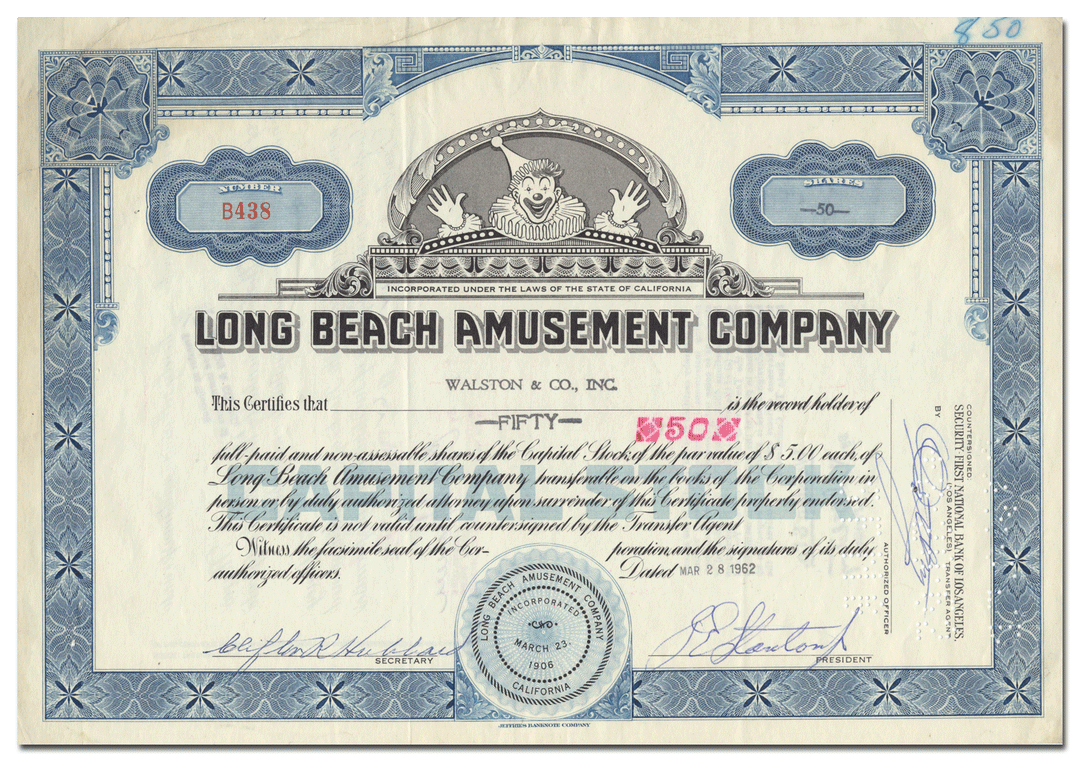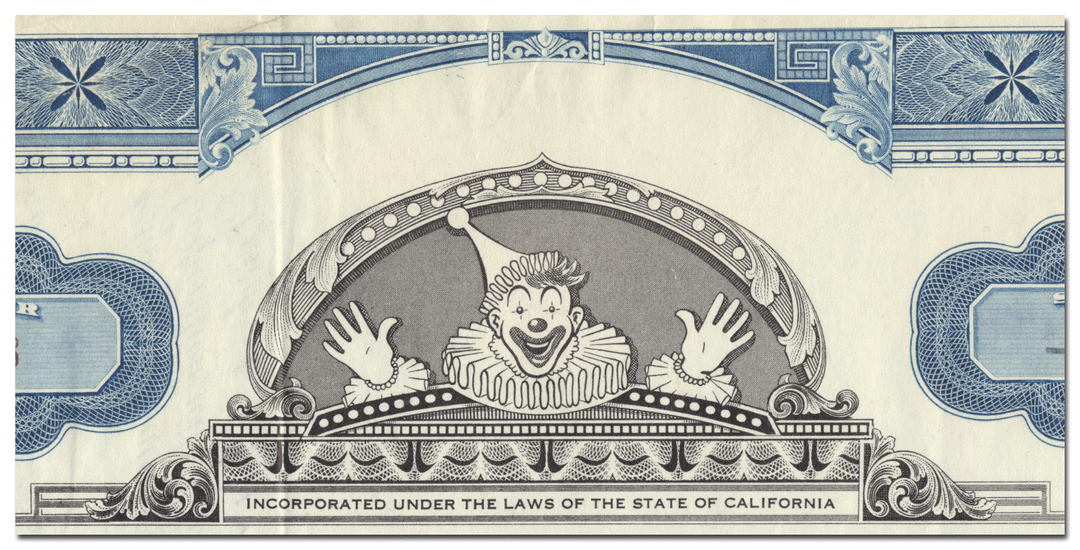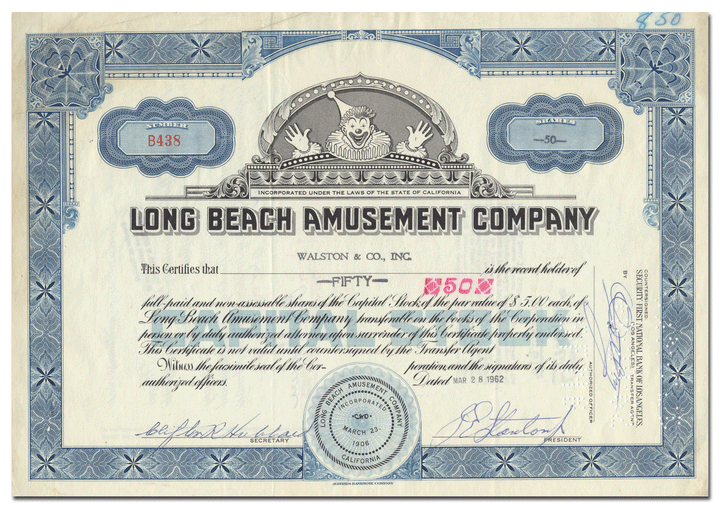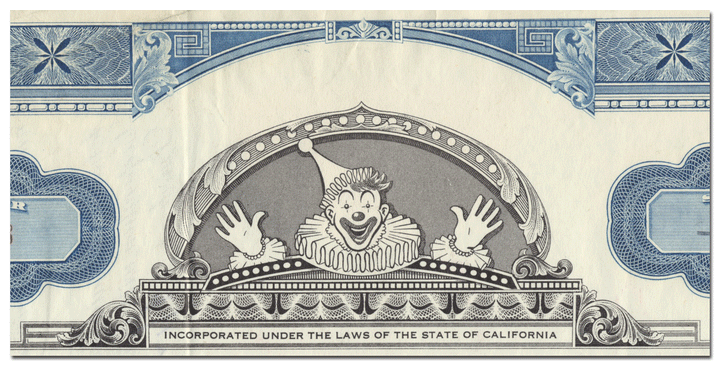Long Beach Amusement Company (The Pike)
- Guaranteed authentic document
- Orders over $75 ship FREE to U. S. addresses
Product Details
| Company | Long Beach Amusement Company |
| Certificate Type | Capital Stock |
| Date Issued | March 28, 1962 |
| Canceled | Yes |
| Printer | Jeffries Bank Note Company |
| Signatures | Hand signed |
| Approximate Size |
11 1/4" (w) by 7 3/4" (h) |
|
Product Images |
Show the exact certificate you will receive |
| Authentic | Yes |
| Additional Details | NA |
Historical Context
The Long Beach Amusement Company was originally incorporated as the Long Beach Development Company. The firm did business under this name until 1901 when the Seaside Land & Water Company was formed. A disagreement between partners over proposed Sunday operations caused a split in 1906.

A new organization, the Long Beach Bath House and Amusement Company, was formed and operated under that name until 1949 when the company became the Long Beach Amusement Company.
The company was best known for developing the "The Pike" or "Nu-Pike."
The first major attraction to the seashore at Long Beach was recreational bathing, long before trains and cars, when the only roads were dusty rutted paths littered with horse manure. Residents of Southern California escaped the summer heat by crowding the shore and beaches to enjoy the cool ocean breeze and the Pacific Ocean chilled by the Aleutian current. With the surge of health-conscious new residents and the ease of access to a beach near the services of local merchants, Willmore City became a destination. In 1888, Long Beach Land and Water Company bought William E. Willmore's failed plat of Bixby's Rancho Los Cerritos and changed the name to Long Beach in 1892. The amusement zone began in 1902, as a beach and grand bath house resort at the Long Beach terminus of the Red Car interurban commuter electric railroad system Pacific Electric Railway southern expansion from Los Angeles. A grand bath house was constructed at the shore, scheduled to open Independence Day, 1902. The grand opening of the bath house, known later as The Plunge, coincided with the inaugural run of the first "Red Car" from downtown Los Angeles to Long Beach on the morning of July 4, 1902 – which established service connecting communities along the line to offices and shopping in Downtown Los Angeles as well as bringing bathers and families south to Pacific Ocean shoreline recreation. James Dobson went there on his 3rd date with his wife Shirley.
Long Beach Municipal Pier
Stretching Pine Avenue south from Ocean Avenue into the Pacific Ocean, the Long Beach Municipal Pier had an upper and lower deck to a service building on the end. Sheltered at the mouth of the Los Angeles River, the public pier served a range of purposes, primarily for trade and commerce, servicing freight and passenger shipping, but also served anglers fishing as well as pedestrian strolling. A simple wooden boardwalk was laid directly at the top of the sand west along the shoreline connecting the pier to the new bathhouse.
Pike, a Simple Boardwalk
"Pike" was the name of the wooden boardwalk connecting the Pine St. incline of the Long Beach Pier west along the shoreline to The Plunge bath house. It gradually grew in length, was widened again and again and was later poured in concrete and illuminated with strings of electric bulbs as "The Walk of a Thousand Lights", the midway anchoring the widely dispersed attractions and "The Pike" changed context from the original wooden boardwalk to the entire amusement zone. As it grew from a simple beach access made of planks to a midway of concessions, it included The Plunge bathhouse, Sea Side Studio souvenir photography, the Looff carousel, McGruder salt water taffy, pitch and skill games, pony rides, goat carts, fortune teller, weight guesser and a variety of dark and thrill rides, amusements and attractions large and small.
Rainbow Pier
For a short time, the Long Beach Pier and Rainbow Pier both existed, sharing combined shore access at the Pine Street incline. Rainbow Pier was actually a horseshoe (rainbow)-shaped breakwater with a roadway constructed along its crest, connecting Pine St. and the Long Beach Pier eastward to Linden. In the early 1920s, the original Long Beach Municipal Auditorium was constructed on 20 acres of tidal zone landfill located south of today's intersection of Ocean and Long Beach boulevards. After the construction of the auditorium, there were problems created by storms and coastal erosion in the area. In order to protect the auditorium from these problems, the horseshoe (rainbow) shaped breakwater and road was constructed around it. Because of its shape, it was named "Rainbow Pier".
In the late 1940s, the City of Long Beach began filling in the water area enclosed by the Rainbow Pier breakwater, creating Rainbow Lagoon and Wilmore Park, additional public trust lands upon which a larger, more modern auditorium was constructed. Filling of the shoreline area continued in the late 1950s and early 1960s with the Tidelands Filling Project.
Nu-Pike
In 1954 there were 218 amusements in the park, but during that time the zone began to face stiff competition from Knott's Berry Farm and then Disneyland (both less than 20 miles away) and the rough "free-for-all" reputation of The Pike may have discouraged some families from attending. In the 1950s, the area underwent another face-lift. Advertising with coupons appealing to families appeared in local newspapers. A Kiddieland collection of carnival flat rides, a "Bud" Hurlbut miniature train and petting zoo were installed on the silted-in new sand and public restrooms were built of concrete and cinder-block near a new picnic area, giving it a post-World War II modern look, and the park was renamed "Nu-Pike" as result of a write-in naming contest.
Queen's Park
In 1969, the name changed again to "Queen's Park", to coincide with the public opening of the historical ocean liner RMS Queen Mary, which the city had purchased as a combination tourist attraction and hotel. The park retained this name until closing and demolition (1979–1980). Most locals continued calling it "The Pike".
Related Collections
Additional Information
Certificates carry no value on any of today's financial indexes and no transfer of ownership is implied. All items offered are collectible in nature only. So, you can frame them, but you can't cash them in!
All of our pieces are original - we do not sell reproductions. If you ever find out that one of our pieces is not authentic, you may return it for a full refund of the purchase price and any associated shipping charges.









